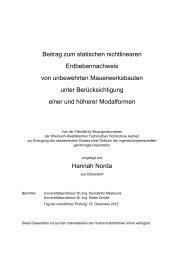Entwicklung eines reaktiven Extrusionsprozesses zur ...
Entwicklung eines reaktiven Extrusionsprozesses zur ...
Entwicklung eines reaktiven Extrusionsprozesses zur ...
Erfolgreiche ePaper selbst erstellen
Machen Sie aus Ihren PDF Publikationen ein blätterbares Flipbook mit unserer einzigartigen Google optimierten e-Paper Software.
8 Zusammenfassung/Summary 127<br />
and combine the different properties of amides and esters. The ester and amide amount<br />
in the polyesteramides as well as their properties can be influenced and controlled<br />
chemically during their synthesis. Especially for biomedical applications polyesteramides<br />
are considered to be an important material. As they are surface eroding polymers, they<br />
are not causing a local in vivo acidity during their degradation and hence are, compared<br />
to other polymers which are used for such devices, avoiding inflammatory responses of<br />
the body.<br />
In this work the synthesis of a polyesteramides with good thermal, mechanical and<br />
processing properties, by using reactive extrusion, is being developed. The focus thereby<br />
lies on the synthesis of thermoplastic polyesteramides. These are mainly produced by<br />
batch synthesis and could not achieve an importance on the market up to now. In<br />
literature examples for the preparation of polyesteramides on a twin-screw extruder using<br />
the monomers ε-caprolactam and ε-caprolactone were reported, but this process has not<br />
achieved any industrial relevance so far. In this work a new synthesis approach for the<br />
continuous synthesis of polyesteramides is presented, which is based on the anionic ring<br />
opening polymerization of ε-caprolactam in the melt of commercially available polyester<br />
- polycaprolactone. The amide fragments are incorporated into the polyester via a chain<br />
transfer reaction during polymerization, which leads to polyesteramides with blocky<br />
nature. As the melt viscosity before and after the polymerization reaction, is comparable,<br />
the process design can easily be simplified, which allows an easier scale-up.<br />
The first part of this work is focused on the chemical development of the reaction and<br />
its evaluation. Furthermore, the requirements for the synthesis on a twin-screw extruder<br />
as well as the required properties of the extrudate and the polymer for such a processing<br />
are defined. To assess and optimize the synthesis the reaction was performed on a<br />
twin-screw microcompounder in batches. The influence of the chemicals and how to<br />
conduct the process, especially regarding temperature and reaction progress are studied.<br />
The characterization of the resulting polymers allowed their subsequent evaluation, and<br />
thus the assessment and evaluation of the chemical reaction and the process. At reaction<br />
temperatures of 180 °C and residence times of ten minutes polyesteramides with blocky<br />
structure were synthesized at high conversion rates. For one of the studied mixtures the<br />
synthesis was carried out continuously on a laboratory extruder with a screw diameter of<br />
16 mm and a L/D=25. The focus lay on the development of the process control as well<br />
as the screw design. Calculations to determine the residence time of the polymer using<br />
a simulation program were performed in order to avoid time-consuming experiments
















